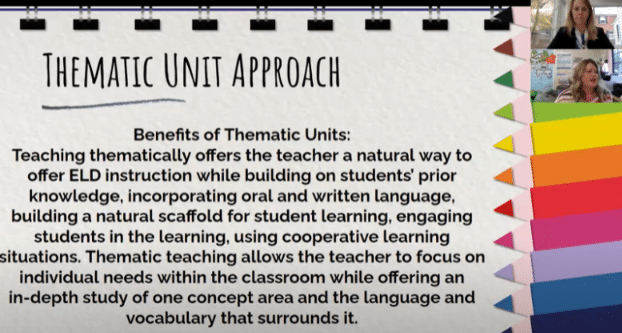Last Updated on January 31, 2023
During our Teacher Talks webinar series last fall, we spoke with Erin Reaves, an English Language Development (ELD) instructional coach at Taylor Elementary in Santa Maria Bonita, CA about how she leads teachers to use Listenwise, not as a supplement, but as the core of instruction for a week of lessons in ELD classes.
Teaching Podcast Lessons within Thematic Units
Reaves explained that her school uses cross-curricular thematic units, which assist emerging bilingual students with acquiring academic vocabulary and content knowledge. She says, “Research shows us that [with] our emergent bilingual students, it is very hard for them to try to learn new content and new language at the same time. So, when we introduce a language skill we want to use it with content that they are familiar with.”

Listenwise works well for the thematic unit approach. Teachers can do a filtered search by topic or use our collections, which include stories curated according to specific themes or topics.
5 Days of Instruction With Listenwise
Following her thematic unit of study, Reaves determines a learning and/or language objective to guide the week of instruction using a single Listenwise story. Reaves outlines her school’s 5-day Listenwise lesson plan for ELD classes as follows:
Monday – Individual Learning (Flipped Classroom Model)
Students work independently to answer a probing question to activate background knowledge related to the audio story before listening to it. They may use an online tool like Padlet to record their answers through different modalities. Students then listen to a Listenwise standards-aligned story and use an accompanying graphic organizer to take notes. Students plan to share what they have learned or noticed during small group discussions the next day.
Tuesday – Small Group Discussion
Teachers establish learning and language objectives for the week and set the expectation for students to share what they learned and noticed from the previous day’s individual listening in their small groups. Small groups work together to synthesize and record their findings to share with the large group.
Wednesday – Whole Group Close Reading
Teachers review learning and language objectives for the week and lead a close reading of the Listenwise story transcript, emphasizing that good readers think while they read, especially about new words that they see or hear. Teachers guide students through opportunities to stop reading in order to think about words that students don’t know, determine what students think are domain-specific words included in the podcast, analyze the text for better understanding, and collaborate with others to express conclusions. Teachers may record the domain-specific vocabulary to form an anchor chart and assign students to add definitions or pictures for homework.
Thursday – Whole Group Comprehension and Discussion Questions
Teachers facilitate a class conversation where students ask and answer the comprehension and discussion questions accompanying the Listenwise story. Teachers may choose to customize these questions to better fit their students’ needs. Teachers should remind students to express their opinions, support their ideas with evidence, and use domain-specific vocabulary words to help them communicate. Students can use the anchor chart from the previous day to help them, and teachers can add the questions and a synopsis of their answers to the chart.
Friday – Written Assessment
Teachers provide a few related questions based on the Listenwise story that students answer in a written paragraph to assess their language and/or comprehension . Students should use the anchor chart of vocabulary and questions and answers as a resource while they write. Teachers may want to work with individual students or a small group of students to guide their writing with more explicit instruction.
Check out Reaves’ full Teacher Talk webinar to learn more about how she uses Listenwise with English language learners – and remember great teaching strategies for ELs is great teaching strategies for all students.
